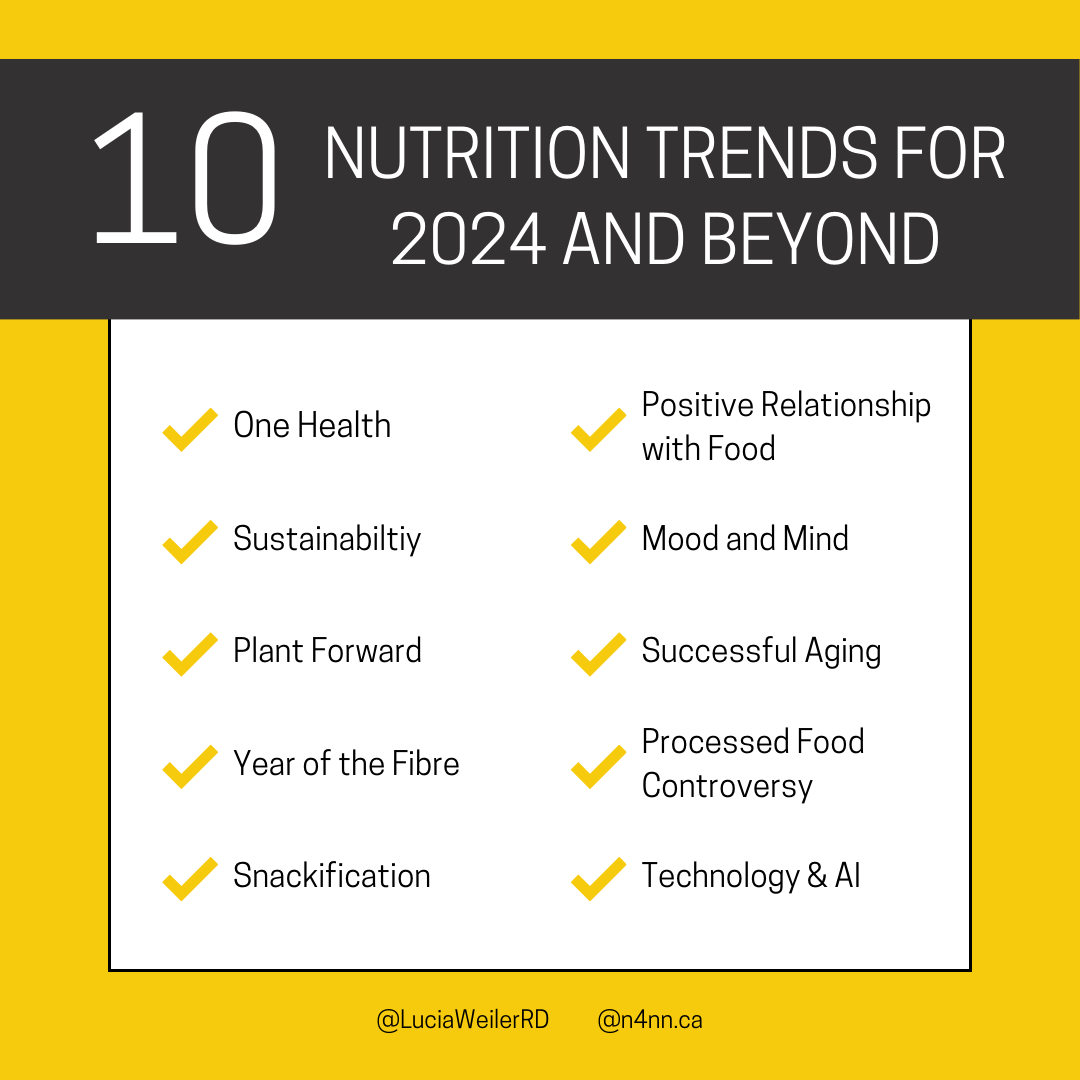
After examining forecasts, here are the 10 key trends in food and nutrition for 2024 and beyond. These trends have enduring impact that will influence food and nutrition businesses and shape the way we shop and eat.
-
One Health
One Health promotes a balanced and healthy future by integrating the well-being of people, animals, and ecosystems. The COVID-19 pandemic highlighted the interconnectedness of humans, animals, and the environment. One Health is a collaborative approach, aiming for optimal health outcomes at local, regional, and global levels by recognizing the ecosystem connections.
Opportunity: Innovations in food production are pivotal for ensuring food security, nutrition, and animal welfare. The WHO supports advancing One Health approaches. (WHO 2017, 2021)
-
Sustainability
Consumers increasingly prioritize sustainability in food choices, seeking options that benefit both people and the planet. Principles of stewardship and responsibility of humans to change behavior and adopt solutions underscore the importance sustainable practices for future generations. (Dvorin, 2022)
Opportunity: Many Canadian companies stepped up with eco-friendly packaging, but much more can be done to communicate clearly and credibly about sustainable choices that are affordable, available and desirable.
-
Plant Forward
The plant-forward trend continues to evolve, accommodating various dietary preferences. It encompasses vegan and vegetarian and flexitarian eating, reflecting a shift towards more plant -based eating while allowing animal foods too. “Think omnivores on their way to becoming flexitarians.” (Culinary Institute of America, 2020)
Opportunity: Consumers seek great tasting and convenient plant based foods both in grocery stores and restaurants. Plant proteins present ongoing opportunities for innovation.
-
Year of the Fibre
Fibre is part of the ‘healthy halo’ yet many people only get half the amount of fibre they need. Fiber-rich eating patterns offer many benefits, including improved digestive health, and reduced risks of chronic conditions like heart disease, diabetes and some types of cancer. Fibre-containing foods include whole grains, vegetables, fruit, legumes and nuts. (Dietitians of Canada, 2018)
Opportunity: Looking for ways to add more fibre to consumers’ eating plan can positively impact overall health. Fibre messages are easy to understand and have strong positive association to digestive wellness.
-
Snackification
Snackification reflects a trend towards consuming larger size snacks throughout the day rather than traditional main meals such as breakfast, lunch and dinner. For example, instead of a morning meal, people may eat a snack right after waking up, then eat another snack mid-morning. Other names for snackification have been “grazing”, eating a “little bit at a time but more often” or simply just “snacking”. This pattern aligns with busy lifestyles, offering convenient and portable food options. (Ceyland, 2023)
Opportunity: Snackification presents an opportunity for diverse, nutrient-dense food offerings that cater to on-the-go consumers. Balanced budget wise snacks could have the edge in these times of rising food costs.
-
Positive Relationship with Food
A balanced eating pattern involves nourishing and optimal food choices. How and why individuals choose the foods they eat reflects their relationship with food. Encouraging a positive relationship with food is essential as consumers move away from restrictive diet culture and discover more about their body’s natural hunger cues. Embracing intuitive and mindful eating approaches fosters balanced eating characterized by lower stress around food and more freedom in food choices. (Turner, 2021)
Opportunity: Supporting individuals in building positive food habits with no restrictions and providing resources for mindful eating can facilitate a shift towards healthier relationships with food.
-
Mood and Mind
Awareness is growing regarding the impact of food choices on mood and cognitive function. Nutrient-dense foods support gut and brain health, with emerging research highlighting the role of the gut-brain axis in overall well-being. (Bending, 2021)
Opportunity: Promoting diverse, nutrient-rich eating patterns can optimize mental function and overall well-being.
-
Successful Aging
Successful ageing emphasizes quality of life beyond the age of 60, focusing on physical, psychological, and social well-being. Research identifies 4 key behaviors, including regular physical activity, balanced nutrition, moderate alcohol consumption, and avoidance of smoking, to promote health in later years. (Willcox, 2012)
Opportunity: Promoting evidence-based behaviors like balanced meals and staying active significantly enhances health beyond 60.
-
Processed Food Controversy
Processing food is a method of production and includes any kind of alteration. Debate surrounds the classification of foods based on level of processing versus nutrition or other food attributes and their impact on health. The levels of food processing—from minimally processed to ultra-processed—influences consumers choices. (British Health Foundation , 2023)
Opportunity: Consumers expect simpler and less processed foods, yet great taste, convenience and affordability are also important factors. Explore options for processing foods and consider nutritional contributions. Offer information on ways to balance convenient foods and boost nutrient density.
-
Technology and AI
Artificial intelligence (AI) is revolutionizing food-related processes, from production to consumption. AI-driven data analytics optimize operations for grocers, while mobile applications assist consumers in navigating food choices, comparing prices and delivery options thereby enhancing convenience and efficiency. AI’s impact is increasingly felt in education and health care, including dietetic practice.
Opportunity: AI tools can help fine-tune processes and provide real-time data to act efficiently and cost-effectively. Further research into the effectiveness and safety of AI-powered nutrition interventions is essential for realizing its full potential. (Bond, 2023)
Contact us for comments or questions.
Written by: Lucia Weiler, BSc, RD, PHEc – Award-winning dietitian and Owner, n4nn
References:
- Bending (2021) Diet and the Microbiota–Gut–Brain Axis: Sowing the Seeds of Good Mental Health https://www.ncbi.nlm.nih.gov/pmc/articles/PMC8321864/?report=classic
- Bond (2023) Artificial intelligence & clinical nutrition: What the future might have in store – https://www.sciencedirect.com/science/article/abs/pii/S2405457723011865
- British Health Foundation (2023) Ultra-processed foods: how bad are they for your health? Ultra-processed foods: how bad are they for your health? – BHF
- Ceyland (2023) Snackification: The Pros and Cons https://healthnews.com/nutrition/healthy-eating/snackification-the-pros-and-cons/
- Dietitians of Canada (2018) Focus on Fibre https://www.unlockfood.ca/en/Articles/Fibre/Focus-on-Fibre.aspx
- Dvorin (2022) One Health: A new definition for a sustainable and healthy future https://www.ncbi.nlm.nih.gov/pmc/articles/PMC9223325/
- Healthline (2020) 5 Tips for Developing a Better Relationship with Food (healthline.com)
- Turner (2021) What Is Intuitive Eating? A Nutritionist Explains https://www.cedars-sinai.org/blog/what-is-intuitive-eating.html
- World Health Organization WHO (2017,2021); One Health https://www.who.int/health-topics/one-health#tab=tab_1
- Willcox (2012) Successful aging: Is there hope? CMAJ https://www.cmaj.ca/content/184/18/1973





 Canadians are more aware of their food choices, shopping smarter, and opting for better nutrition now more than ever before. Dietitians remain the most credible source of food and nutrition information and consumers seek accurate, practical advice to improve the way they eat and feel. This means that more employers are realizing the value that a trusted dietitian advisor can bring to a workplace.
Canadians are more aware of their food choices, shopping smarter, and opting for better nutrition now more than ever before. Dietitians remain the most credible source of food and nutrition information and consumers seek accurate, practical advice to improve the way they eat and feel. This means that more employers are realizing the value that a trusted dietitian advisor can bring to a workplace.




 Image Health Canada
Image Health Canada






 Image Source: Dietitians of Canada
Image Source: Dietitians of Canada







 1. What’s your cultural background?
1. What’s your cultural background?





